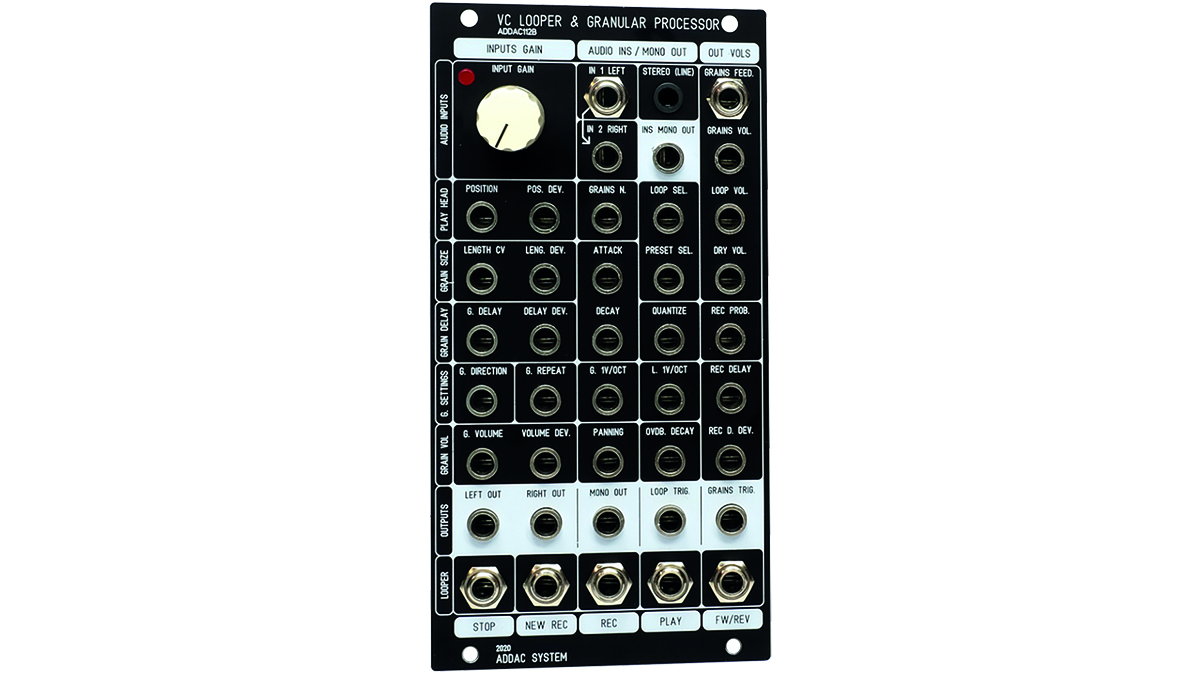MusicRadar Verdict
A looper’s dream. The extended buffer sizes, ease of use and complete levels of CV control are a joy. Worth every HP it uses.
Pros
- +
Pretty much knob-per-function.
- +
Excellent, intuitive workflow.
- +
Good value.
Cons
- -
Not the smallest of modules.
- -
MusicRadar's got your back
ADDAC 112 : What is it?
At 32hp, plus an additional 14hp for the expander, the ADDAC112 is an impressive module to behold and that space is put to very good use, so don’t be put off by the size.
It’s split into two parts but both are needed, so don’t think that the expander is optional; it is in fact vital, as it houses all the I/O for the module. This is a good move by ADDAC as it means all patching is in one movable zone, so you can place it where it suits your rig best, leaving the control section clear for adjustments and performance.
As with other ADDAC modules, the build is excellent, the design no-nonsense, easy to read and logical. For a module of this size and capability it has a relatively modest power consumption and rearward needs, at just 4.5cm deep and requiring just 240mA +12 and 70mA -12.
The screen is bright and don’t be put off by thinking it means endless menu diving. It really doesn’t at all. In fact the data dial and screen are mostly used for saving and loading loops and presets and a few settings that will likely be set and forgotten. The screen really comes into its own in conjunction with the rest of the module.
ADDAC 112: Performance and verdict
Starting with looping, there are inputs for various types of signal, from split stereo (normalled 1 to 2), single line-in stereo and gain control. Other than the outputs, the patch module is for CV control of just about every element the 112 has to offer.
Pressing the record button starts the huge 5-minute buffer, which can be heard by adjusting the dry, loop and grain volumes. New recordings can be made, as can overdubs, with the punch-in point easily assignable. Playback can be done manually or by CV, so a simple save makes it easy to trigger playback in live situations where free hands become rare.
Granular is equally simple but powerful and here the ADDAC112 really shines, the control layout making easy work of setting up the ideal configuration. Controls for start point, grain count, spacing, stereo positioning and more are all there and each has a secondary control for deviation, essentially randomising the element increasingly as the knob is turned. The audio waveform is shown onscreen, as is the playhead and the grains themselves, making it remarkably easy to dial in a sound.
Want all the hottest music and gear news, reviews, deals, features and more, direct to your inbox? Sign up here.
Grains can be synced to the looping audio as well, at either eight or quarter, or left free-running, set by a small toggle switch next to the corresponding knob.
Playback can be constrained to scales or run from a volts per octave input. There’s a CV-controllable knob for octave range as well.

The key to the success of the 112 is in the CV control and visual feedback. It is fantastic, hands-on and many will use it this way, but spending some time with the CV control and various trigger sources brings this module to another level. Pretty much everything can be controlled this way and having the patch bay separate is a big deal – well done ADDAC.
Triggering or modulating attributes with CV is a real pleasure, while the screen gives real-time feedback that helps you see what your modulation choices are doing. The only place with such a close link is the Waldorf Iridium, at least in such an intuitive way. This workflow is fantastic, especially when there are so many small changes that have a large impact on overall output.
Finally, the screen easily allows the creation, saving and loading of banks and presets, to the SD card, loadable directly from a knob or by CV. There is much more to the 112 and the manual is very good too, so learning it is simple and fun.
MusicRadar verdict: A looper’s dream. The extended buffer sizes, ease of use and complete levels of CV control are a joy. Worth every HP it uses.
ADDAC 112: Hands-on demos
Monotrail Tech Talk
Omri Cohen
ADDAC 112: Specifications
- KEY FEATURES 5 minute buffer size, Excellent screen and UI, Movable patch bay, Looper and granular synthesis
- CONTACT: Addac System
